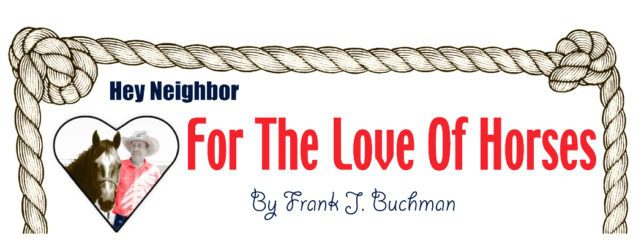They were all a long ways from home, but the rodeo action was much the same..
Spectators at a dozen rodeos in Spain may have been even more enthusiastic about the traditionally U.S. sport than had the performers been in their homeland.
“It was really an exciting time for all of us, and the crowds were just phenomenal,” described Bronc Rumford, the man responsible for those overseas spectaculars.
News of the Abbyville cowboy’s plans last spring to take rodeo livestock, along with contestants and even a rodeo arena to Europe drew some doubt, if Rumford could complete the giant endeavor.
Well, he did. Rumford returned to Kansas last week and was at the American Royal Livestock Show in Kansas City over the past weekend with his adrenalin seemingly overflowing.
“Everything went well. Everybody had just a great time,” Rumford said. “We had 12 performances at nine venues. Attendance ranged to more than 20,000, and our smallest crowd was still about 5,000.
“This was really the first time in Europe for a full-scale, traditional American rodeo,” he added.
Spectator appreciation was amply expressed by applause and verbal raves, but there was one problem. “We really couldn’t understand what they were saying,” Rumford recognized.
That’s the reason a native of that country was called in to be the announcer. “He really did a good job, and worked well with all of us,” Rumford credited. “There were a few of our group who could also speak Spanish, along with translators, so it was fine.”
While Rumford, as a second generation rodeo contractor, has trucked his rodeo stock from coast to coast and shipped horses to nearly a dozen overseas ports, this “was a completely different deal.”
It was not only gathering up the livestock, but also the cowboys and all of their tack, plus the portable arena, complete with chutes.
Although there was no shortage of qualified horses at the Rumford Rodeo Ranch, most of them didn’t go. “We didn’t bring any of the horses back to the United States, so we didn’t take our best ones,” Rumford qualified.
A number of the horses were also provided by other Professional Rodeo Cowboy’s Association contractors from Montana to Texas. Included were 38 bucking horses, several used both bareback and under saddle. There were 22 broke horses for roping, barrel racing and steer wrestling in addition to handling the livestock.
Even though he’s shipped as many as 45 horses to places like Finland and Japan, this was Rumford’s largest shipment, and the first time from the Kansas City International Airport.
Horses were transported in a Boeing 747-400F, which is the largest freighter in the industry. It is three-fourths the length of a football field, has a 70-yard wingspan, is the height of a six-story building and weighs 265,000 pounds. Horses in groups of four were placed in shipping containers before being loaded on the airplane.
“Three cowboys went with the horses which were not sedated, but the crew was equipped with tranquilizers in case of an emergency,” qualified Rumford. The horse flight left September 3, but Rumford and the rest of his rodeo outfit followed on a traditional airline a few days later. The first performance was in Madrid on September 17.
“There were 60 of us who made the trip,” Rumford explained. “These were professional rodeo cowboys and cowgirls, who competed in the rodeos, some in several events.” Rodeo announcer Brent Jordan assisted the Spanish announcer and handled the music for the rodeos, and trick rider-roper Max Reynolds was also on the tour.
Health regulations prohibited Rumford from taking any cattle from this country. “We got the bucking bulls from Italy, and the timed-event cattle came from Spain,” Rumford related. “The bulls had been bucked some at a local rodeo there. They weren’t the caliber we have here, but worked out fine.”
Cattle used for roping and bulldogging were unique to Rumford. “I really don’t know what breed they were, but they had some fighting bull in their blood,” he commented. “None of them were too bad to handle. Of course, we did have to train the cattle out of the box, and their horns are different than what we’re accustomed to.”
Everybody pitched in to help as the complete rodeo was moved to the various locations. “We’d have from five to seven contestants in each event, along with the contract acts, so the performances were about two hours,” Rumford detailed.
A number of the contestants have been National Finals Rodeo qualifiers, but the star of the overseas rodeos had to be Seth Shafer, who entered in every cowboy event, and won some of both the timed and rough stock competitions. “We really had a great group,” noted Rumford, also a champion who kept busy overseeing the productions.
Originally, it was said that the horses would be sold at the completion of the tour. However, Rumford revealed, “Most of the horses will be retained there for a PRCA-sanctioned rodeo promoters have planned in two years. This was kind of a warm-up for that tour.”
Overhead is high for an affair of this magnitude, but it turned out to be a profitable venture, according to Rumford. “Contestants received salaries, transportation and lodging plus competed for a purse at each rodeo, so they came out all right. The whole operation cost about $3 million,” Rumford figured.
Admitting the overseas production was a “huge undertaking,” Rumford insisted, “It really turned out good.”
Rumford, coach of the Fort Hays State University Rodeo Team in addition to his many other ventures, was busy at the American Royal managing the Prairie Circuit Pro Rodeo Finals.
+++
